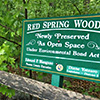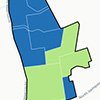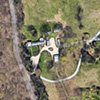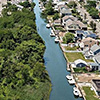Most land preserved through bond acts was on North Shore
All involved acknowledge there was more available open space there, but some argue that more South Shore land might have been included if one advocacy group hadn’t played such a large role.
Nearly 95 percent of the land preserved under Nassau County’s environmental bond acts was located on the North Shore – much of it portions of estates in exclusive Oyster Bay villages.
All involved in the program acknowledge that there was simply more available open space on the North Shore, since most in the more densely populated central and southern portions of the county were already preserved as state or municipal parkland.
But some argue that the split might have been slightly less disproportionate if the role of one advocacy group hadn’t loomed so large in the results.
The North Shore Land Alliance, a nonprofit formed in 2003, not only lobbied for passage of the 2004 and 2006 county bond acts – putting more than $200,000 into a political action committee that promoted the latter referendum – its members also nominated properties that were purchased with some of the $100 million in dedicated open space funds, and it had representation on the advisory committees that ultimately recommended those properties.
“They had a lot of influence,” said Victor Consiglio, a former South Shore resident who volunteered in waterway cleanup efforts and served on one of the bond act advisory committees. “There was pressure to try and get these bigger pieces up on the North Shore. The threat was: If we don’t buy it, the owners were going to sell it to developers.”
The bond act advisory committees were primarily appointed by then-County Executive Thomas Suozzi, a Glen Cove Democrat who now represents the 3rd Congressional District. They included Land Alliance president and CEO Lisa Ott and several of the nonprofit’s board of trustees or advisory board members.
After the county’s environmental bond committee recommended its first set of properties for purchase in March 2006, the Land Alliance chairman, Carter Bales of Centre Island, and vice chairman, Luis Rinaldini of Old Westbury, gave Suozzi’s 2006 failed gubernatorial campaign a combined $4,500 over the next four months, records show. In the years since, they and their families have given his county executive and congressional campaigns another nearly $17,000 in total.
“I simply thought Tom was the best candidate for the job,” Bales said in an email, adding that Suozzi, to his memory, never solicited a campaign contribution.
Rinaldini said in an interview that he had supported Suozzi long before the bond acts: He met him in Glen Cove, before Suozzi was first elected the city’s mayor in the early 1990s, and although he is a Republican he consistently backed the Democrat’s campaigns both before he was elected Nassau County executive and his subsequent bids for higher office.
“Politicians get forced into certain things they can’t avoid: fundraising, etcetera,” Rinaldini said. “But at the end of the day there are some that are better than others, and Tom is one of those that, universally, he genuinely is better than others.”
A Land Alliance advisory board member at the time, attorney Peter MacKinnon, represented at various times, five landowners in their open space deals with the county, worth a combined $34.6 million.
MacKinnon, who has served as the village attorney for a number of North Shore villages, said in an email that he was referred to those sellers by a variety of sources, including a county real estate negotiator he had worked with on a prior deal. He said he inherited others from a former law partner, but did not cite the Land Alliance as a factor.
Still, one county bond act advisory committee member said he felt the Land Alliance “had a very large influence” on the program.
“They seemed to be rewarding certain people, and the benefit to residents and the taxpayers that were funding this was not necessarily realized as it should and could have been,” said Dan McCloy, who served on the committees as representative of the county legislature’s then-GOP minority.
Suozzi declined to speak in detail about the bond acts. But in a brief interview, he characterized the property vetting as “a rigorous process with an independent committee of respected environmentalists.”
According to an internal list of nominations under the second bond act, provided to Newsday by a person involved with the bond act advisory committee, the committee gave its top “A” ranking to 25 properties on the North Shore, encompassing more than 800 acres, and to 21 properties in the central or southern parts of the county, totaling about 120 acres.
Ultimately, the committee formally recommended purchase of 16 of the 25 top-rated North Shore properties, or 64 percent, but did the same for just 8 of the 21 top-rated properties elsewhere in the county, or 38 percent.
Ott, who was seen by other members as having the most knowledge of available land, said the advisory committee seriously reviewed all nominations over many months, after months of soliciting public input.
But it became clear, she said, that the land on the North Shore – much of which was in a state designated Special Groundwater Protection Area – provided the best ecological benefit and the best value, as land prices in parts of the county where denser development was allowed were much higher.
“You can buy one acre on the South Shore that might cost $2 million or you could buy 10 acres in the middle of the Special Groundwater Protection Area that costs $2 million,” Ott said. “So which is going to do the most good?”
Though the Land Alliance can acquire land for preservation on its own through purchase or gift, providing tax benefits to the owners, it found public purchase a better alternative.
“NSLA realized early on that many people could not afford to donate their land for conservation purposes,” the Land Alliance wrote in a 2006 newsletter. “As a result, we worked hard in 2004 to get the Nassau County Environmental Bond Program on the ballot and passed.”
Cynthia Cooper, a former Lakeview civic activist who served on both advisory committees and was involved in local Democratic politics, didn’t fault the North Shore Land Alliance. She said she was impressed by the natural beauty of a lot of the sites the group championed and said it was simply the “more proactive” of organizations involved in the process.
“They were ready when the money came through,” said Cooper, who worked to get some bond act funding for park improvements in minority communities such as Lakeview and Roosevelt. “When people are conscious of what’s happening in their community, they’re going to make out better than we are.”

 Overview:
Overview: Map:
Map: Part 1:
Part 1: Part 2:
Part 2: Part 3:
Part 3:


 Video:
Video: